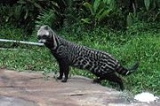
Civet
Overview
The family
Viverridae is made up of around 30 species of medium-sized mammal, including all of the genets
, the binturong
, most of the civet
s, and the two African linsangs.
Viverrids are native to most of the Old World tropics, nearly all of Africa
(bar the area immediately south of the Mediterranean), and the Iberian Peninsula
. Favoured habitats include woodland, savanna, mountains and, above all, tropical rainforest
. Due to heavy deforestation, many are faced with severe loss of habitat; several species are considered vulnerable (such as the rare Hose's Civet
, endemic
to northern Borneo
), and the Otter Civet
is classified as endangered.
Viverrids are amongst the primitive families of the Carnivora
, with skeletons very similar to those of fossils dating back to the Eocene
, up to 50 million years ago.
Family (biology)
In biological classification, family is* a taxonomic rank. Other well-known ranks are life, domain, kingdom, phylum, class, order, genus, and species, with family fitting between order and genus. As for the other well-known ranks, there is the option of an immediately lower rank, indicated by the...
Viverridae is made up of around 30 species of medium-sized mammal, including all of the genets
Genet (animal)
Genets are Old World mammals from the order Carnivora, family Viverridae, related to civets and linsangs. All species are contained within the genus Genetta, although the Aquatic Genet is sometimes housed in its own genus Osbornictis....
, the binturong
Binturong
The Binturong , also known as the Asian Bearcat, the Palawan Bearcat, or simply the Bearcat, is a species of the family Viverridae, which includes the civets and genets. It is the only member of its genus...
, most of the civet
Civet
The family Viverridae is made up of around 30 species of medium-sized mammal, including all of the genets, the binturong, most of the civets, and the two African linsangs....
s, and the two African linsangs.
Viverrids are native to most of the Old World tropics, nearly all of Africa
Africa
Africa is the world's second largest and second most populous continent, after Asia. At about 30.2 million km² including adjacent islands, it covers 6% of the Earth's total surface area and 20.4% of the total land area...
(bar the area immediately south of the Mediterranean), and the Iberian Peninsula
Iberian Peninsula
The Iberian Peninsula , sometimes called Iberia, is located in the extreme southwest of Europe and includes the modern-day sovereign states of Spain, Portugal and Andorra, as well as the British Overseas Territory of Gibraltar...
. Favoured habitats include woodland, savanna, mountains and, above all, tropical rainforest
Tropical rainforest
A tropical rainforest is an ecosystem type that occurs roughly within the latitudes 28 degrees north or south of the equator . This ecosystem experiences high average temperatures and a significant amount of rainfall...
. Due to heavy deforestation, many are faced with severe loss of habitat; several species are considered vulnerable (such as the rare Hose's Civet
Hose's Palm Civet
The Hose's palm civet , also known as the Hose's civet , is a civet found in Borneo. It is named after zoologist Charles Hose and is a member of the family Viverridae...
, endemic
Endemic (ecology)
Endemism is the ecological state of being unique to a defined geographic location, such as an island, nation or other defined zone, or habitat type; organisms that are indigenous to a place are not endemic to it if they are also found elsewhere. For example, all species of lemur are endemic to the...
to northern Borneo
Borneo
Borneo is the third largest island in the world and is located north of Java Island, Indonesia, at the geographic centre of Maritime Southeast Asia....
), and the Otter Civet
Otter Civet
The Otter Civet, Cynogale bennettii, is a semi-aquatic civet found in forests, primarily lowland, near rivers and swampy areas of the Thai-Malay Peninsula, Sumatra, and Borneo. An additional population, only known from single specimen, occurs in northern Vietnam...
is classified as endangered.
Viverrids are amongst the primitive families of the Carnivora
Carnivora
The diverse order Carnivora |Latin]] carō "flesh", + vorāre "to devour") includes over 260 species of placental mammals. Its members are formally referred to as carnivorans, while the word "carnivore" can refer to any meat-eating animal...
, with skeletons very similar to those of fossils dating back to the Eocene
Eocene
The Eocene Epoch, lasting from about 56 to 34 million years ago , is a major division of the geologic timescale and the second epoch of the Paleogene Period in the Cenozoic Era. The Eocene spans the time from the end of the Palaeocene Epoch to the beginning of the Oligocene Epoch. The start of the...
, up to 50 million years ago.
Unanswered Questions

